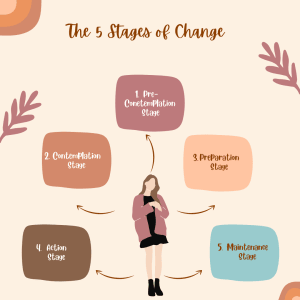
Are you ready? This is the most important question you must ask yourself to know where you fall in the behavior change continuum. The behavior change continuum involves 5 different stages: Pre-Contemplation, Contemplation, Preparation, Action and Maintenance. Although there are 5 separate stages in behavior change, people can cycle back and forth when it comes to their readiness for change. Therefore, most of the time progress is not linear as humans typically revert back to old habits even if it's just temporarily. It is important to know how to identify what stage you are in first. This blog is to help you do just that. For the purpose of this blog, we will use the example of exercising as the behavior changed.
The 5 Stages of Change
Let's start with the Pre-Contemplation Stage. For at least the past 6 months, you have had no intention to change or start a new habit. There has been no thought in your head that the behavior you are engaging in is disrupting or causing distress in your life. At this stage you do not perceive a need for change, Various reasons may come in for having this mindset. One may have had negative experiences in the past, lack social support from anybody, be self-conscious about themselves around others, lack sufficient funds to join a gym or fitness club or the live too far away from available programs and facilities. if you are not ready for change, then you fall in the Pre-Contemplation Stage.
The next stage is Contemplation. In the next 6 months, this person intends to change or start a behavior. If you are in this stage you have learned or encountered information or experiences through various avenues that have led you to feel that change is necessary. At t his point, the cost and consequences of the person's behaviors are becoming excessive and damaging. The benefits to changing that behavior are more and more attractive. Lots of people get stuck in this stage saying to themselves and others that someday they will change, but continue to put it off sometimes for 2 years or more. These people are called chronic contemplators.
The third stage is Preparation. If you are in this stage you are now more serious about putting forth effort to change or start a behavior, typically within a month. At this time an action plan is formulated, either by the person or with the help of someone else like a health coach. You may start looking to join a gym membership, buy workout attire, find friends or family to workout with you, and research exercises or personal trainers. In the preparation stage the person is not yet fully committed to the plan because the disadvantages (such as not enough time, physical discomfort due to exertion, cost of membership, or lack of equipment) still outweigh the advantages.
The forth stage is Action. For less than 6 months this person has initiated the exercise plan and is putting forth effort. Now they are not only talking the talk, but walking the walk. Although the person is now focusing much of their attention and energy into the new behavior, the exercise regimen, quitting and reverting back to old habits is still very possible. During this stage the person learns how to work around obstacles to stay consistent in their behavior change journey. It is very likely the person will need to cycle back to contemplation or preparation to figure out what is best for obstacles when they arise.
The final stage is Maintenance. After 6 months of consistent action, the person now falls in the maintenance stage. The likelihood for this person to stop acting on the new behavior is now much less, but still possible. Research has shown that exercising for at least 5 years will turn a temporary habit into a permanent lifestyle. Being in the maintenance stage, the person now has the tools and resources needed to work around any obstacles that may interfere with the desired behavior change.
In Summary...
So is it possible to fall into multiple stages at the same time? Yes it is. Is it possible to cycle back and forth between the stages? Yes it is. Are there tools that can be used to prevent relapse? Yes there are. Just as there are situations that challenge people's confidence in their ability to meet their goals, there are tools that can help increase that person's confidence. Increasing Self-Regulatory Efficacy, or Self-Confidence, is one of the major keys to behavior change. To learn more about creating a long lasting and sustainable behavior change, talk to one of our Health Coaches at GoTimeTraining!
-Caleb Campbell-
Masters in Kinesiology
Certified Personal Trainer - NASM, BCS



